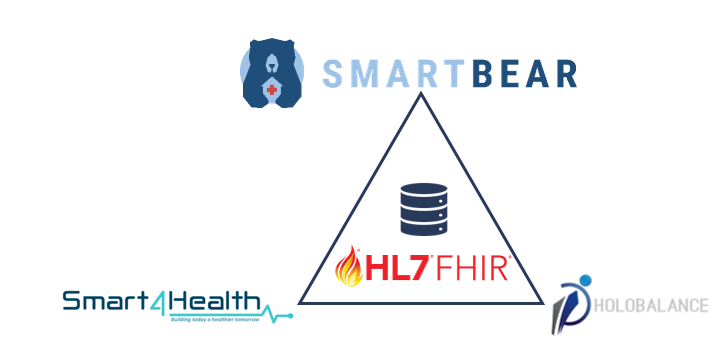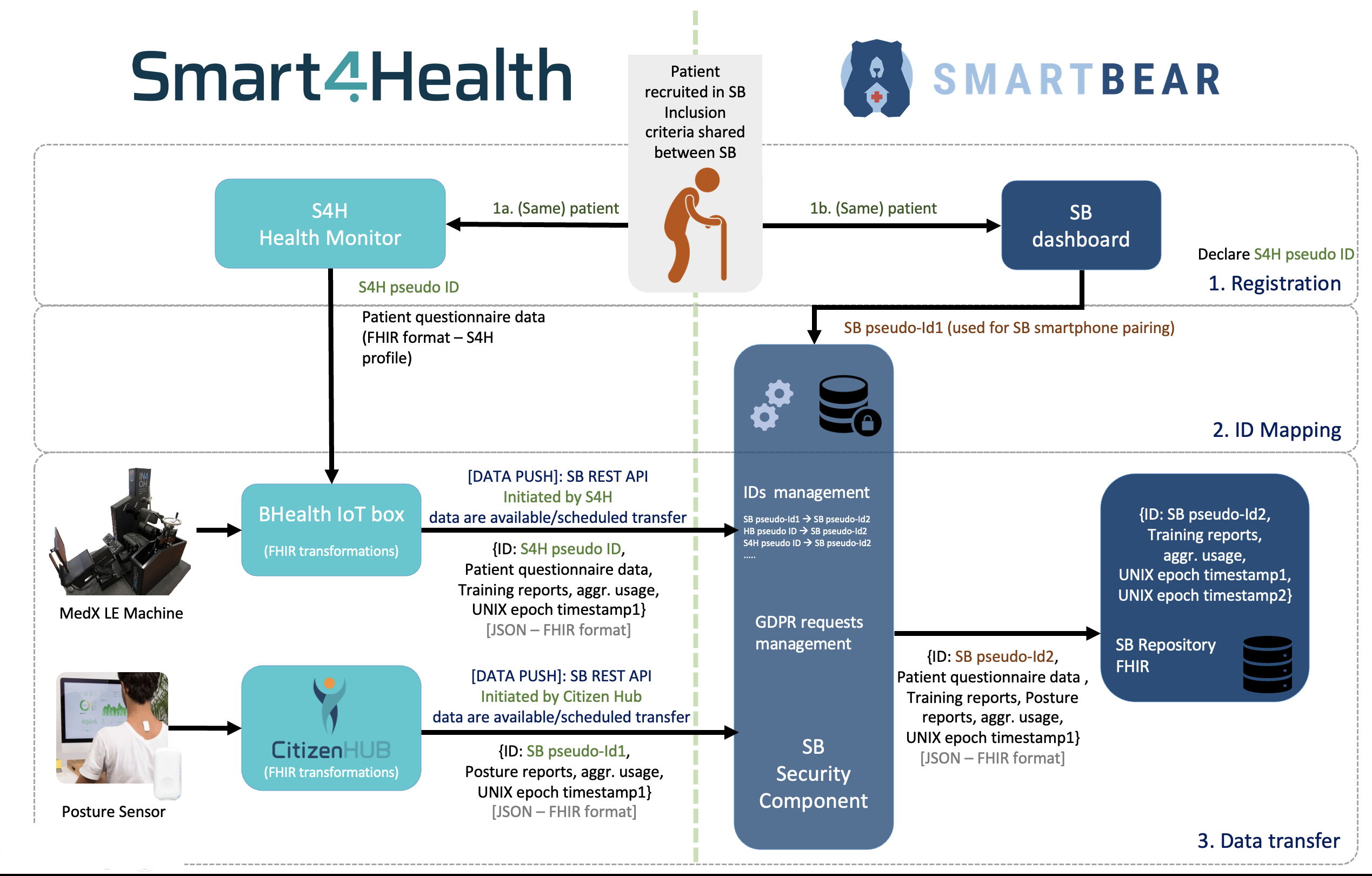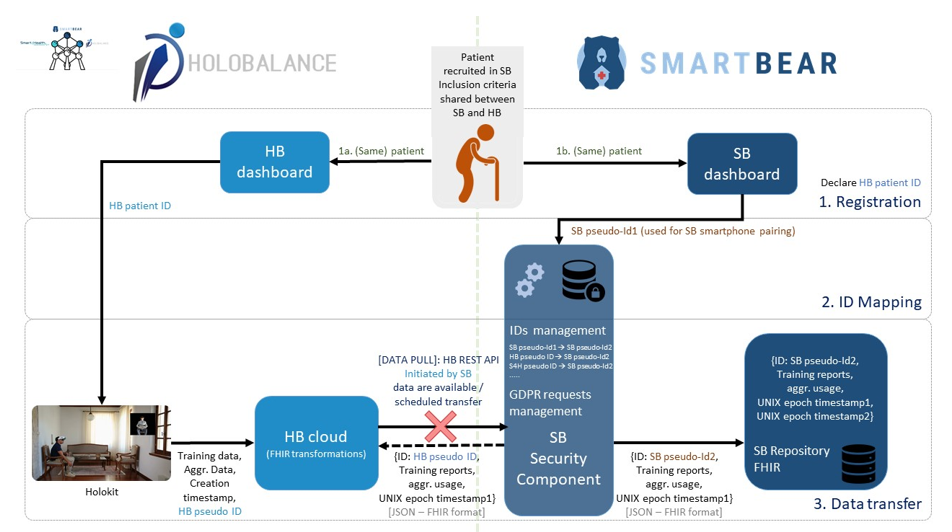Smart Bear Implementation Guide - Local Development build (v0.3.2). See the Directory of published versions
Pilot Of Pilots
Synergies |
Pilot of the Pilots and Synergies
The Pilot of the Pilots (PoP) in Madeira is a smaller subset of the Italy-Portugal large-scale pilot that includes 100 patients to demonstrate the project concept feasibility prior to the kick-off of the large-scale pilots. It had the main objective to test the first release of the SMART BEAR infrastructure as a prerequisite for the additional five pilots, and to show the synergies implemented with the Smart4Health and Holobalance EU projects, highlighting mutual cooperation and interaction between complementary solutions that are evolving at different paces.
Pilot of the Pilots and Synergies Holobalance data in SMART BEAR
Collaboration with the Smart4Health project targets patients suffering from low-back pain (LBP) and is facilitated due to the geographical incidence, being Madeira a pilot region in both projects. Patients with balance disorders can also benefit from the collaboration with the HOLOBALANCE project. The demonstration of the synergies with the Smart4Health and HOLOBALANCE EU projects is a core objective of the pilot of pilots not only at clinical level, sharing some of the studied comorbidities but also at technical level, ensuring that developments (tools) and data is being shared between projects. In the PoP there was the need to integrate some components so that the SMART BEAR cloud gains access to posture and training data using FHIR hence enriching the clinically relevant information about each patient and allowing the creation of more personalised insights both for the clinicians and for the patients. An example use-case for the Smart4Health synergy is explained next.
Figure 1 |
All patients are to be engaged in the LBP physiotherapy training, which foresees a first appointment to perform a force test. This is an exam to assess and define the parameters of the exercises that compose the actual LBP physiotherapy training in a personalised way for the subsequent training sessions.
Force Test
In Smart4Health, when a patient finalizes a force test, the physiotherapist presses the finish button on the platform UI. At that moment, a document in json is generated and sent to the BHealth IoT Box containing the summary of the action. The BHealth IoT Box gathers that data and joins the local information gathered from the force test and creates a FHIR DiagnosticReport respecting the profile of LumbarForceTestDiagnosticReport, and where all relevant observations are contained. An attempt is then made to send it to the Smart Bear platform. If it fails, it will schedule the upload for a later date.
Training
The training follows the same pattern as the force test, but the resource generated is a LumbarTrainingDiagnosticReport.
Posture
A patient using Citizen Hub and a posture sensor will collect posture data throughout the day. Once every day, a check is made to evaluate if there are data points that have not been sent to Smart Bear. Once a data point is found to be needing synchronization, an aggregation of data over a period of one day is performed and a FHIR DiagnosticReport respecting the profile of DailyPostureDiagnosticReport is generated, along with observations respecting the profiles of NormalPostureObservation and PoorPostureObservation. These resources are then bundled and an attempt is then made to send it to the Smart Bear platform. If it fails, it will schedule the upload for a later date.
Resources Synergies List
Questionnaires
- Back pain prevention questionnaire
- Pre-session questionnaire
- Post-session questionnaire
- Pre-training questionnaire
- Back pain post-training questionnaire
Diagnostic Reports
Observation
Pilot of the Pilots and Synergies Holobalance data in SMART BEAR
In HOLOBALANCE system, an edge server acts as an intermediary between the front-end user interface and the backend (Fig. 2). The edge server calculates the exercise assessment results from the sensors data streams in a proprietary JSON format and then sends those results to the backend for further processing and storage. The backend processes these results, converting them into the Fast Healthcare Interoperability Resources (FHIR) format. FHIR is a standard format for exchanging electronic healthcare information between different systems. Once the results are in the FHIR format, the HOLOBALANCE backend posts the results back to the SMARTBEAR backend for further processing or storage. This allows for interoperability between different systems and ensures that the information can be shared and used by a variety of healthcare providers and systems. Overall, the process of converting the proprietary JSON format to FHIR allows for the seamless exchange of healthcare information between systems, improving the overall efficiency of the healthcare delivery process.
Figure 2 |
More specifically, the following entities and processes are involved:
- Edge Server: The edge server is responsible for receiving the sensors’ datastreams, performing the necessary calculations, and forwarding the requests to the backend. In the case of exercise assessment results, the edge server may perform validation on the incoming JSON data to ensure that it is in the correct format, and then convert it into a format that can be processed by the backend.
- Backend Processing: The backend processing component of the HOLOBALANCE system is responsible for converting the incoming exercise assessment results from the proprietary JSON format into FHIR format. This conversion process may involve mapping values from the proprietary format into the corresponding values defined in the FHIR standard. The backend also performs additional validation and processing on the converted data to ensure that it is in the correct format and ready to be posted to the SMARTBEAR backend.
- FHIR Format: FHIR is a standard format for exchanging healthcare information between different systems. It defines a set of resources, such as Patient, Observation, and Encounter, that represent common types of healthcare information. Each resource has a set of mandatory and optional fields, and the data is transmitted in a JSON or XML format. By converting the exercise assessment results into the FHIR format, your system can ensure that the results are compatible with other systems that support the FHIR standard.
Resources Synergies List
- HolobalancePatient
- ExerciseWalking2WalkAndYaw
- ExerciseWalking3WalkPitchVShaped
- CognitiveGamesAnimalFeeding
- CognitiveGamesBridgeCrossingMarbleGame
- CognitiveGamesCatchingFood
- CognitiveGamesMemoryGame
- CognitiveGamesPreparingAnimalFood
- CognitiveGamesRememberPrevious
- ExergameSitting1Yaw
- ExergameSitting2Pitch
- ExergameStanding1MaintainBalance
- ExergameStanding3Bend
- ExergameStanding3ReachUp
- ExergameWalking1WalkToHorizon
- ExergameWalking2WalkAndYaw
- ExergameWalking3WalkAndPitch
- ExergameWalking3WalkAndVShaped
- ExerciseSitting1Yaw
- ExerciseSitting2Pitch
- ExerciseSitting3Bend
- ExerciseStanding1MaintainBalance
- ExerciseStanding2MaintainBalanceOnFoam
- ExerciseStanding3BendAndReachUpProg0
- ExerciseStanding3BendAndReachUpProg2
- ExerciseStanding3BendAndReachUpProg3
- ExerciseStanding4Turn
- ExerciseWalking1WalkToHorizon


